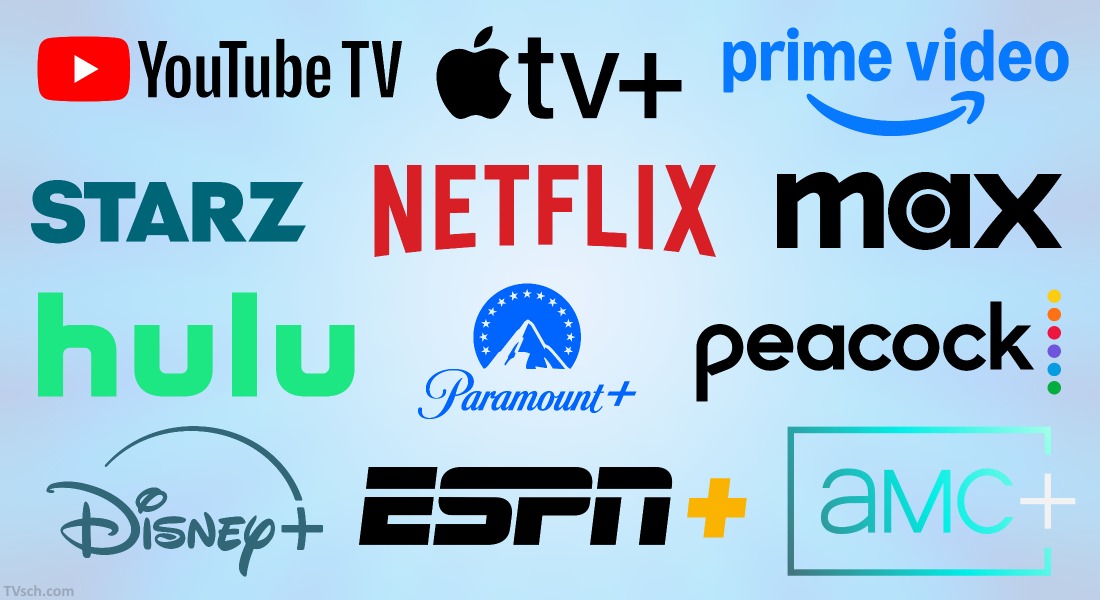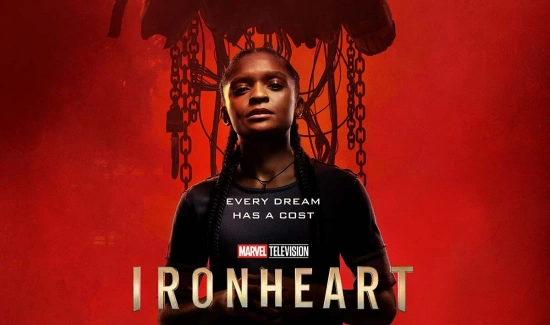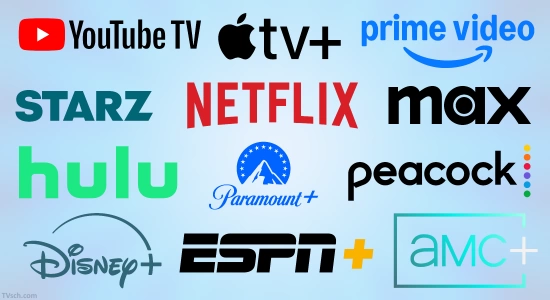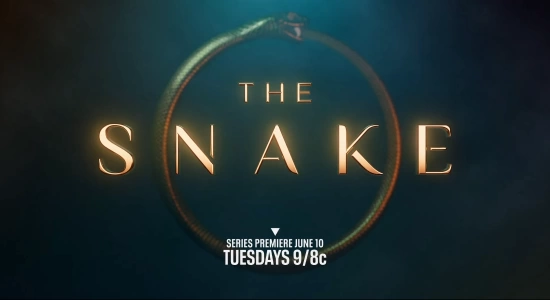Top U.S. Streaming Services as of May 2025: Features & Prices
TVsch Blog / Mike Dawson / May 10, 2025

Remember those good old days when "streaming" mostly meant Netflix, and maybe, just maybe, Hulu for the really tech-savvy? Now, try to name all the platforms you’re subscribed to from memory, without peeking at your bank statement. Hard, right? Because there are so many of them now that if you pay for everything, you might not have enough left for popcorn and a soda for your evening binge-watch.
Once upon a time, Netflix was this kind of revolutionary, who came along and said, "Hey, cable TV is so last century; let’s watch shows without ads and extra wires." And everyone rejoiced. And then… then everyone else rejoiced too. Disney remembered it had Marvel, Star Wars, and mountains of content it could monetize. HBO thought, "Why are we giving our hits to someone else?" Amazon, with more money than common sense, just tossed a couple of billion into production—just in case something hit.
And here we are. In an era where subscribing to all the major streaming services will cost you more than a gym membership (that you’ll probably end up not using anyway). When every month a new service pops up that’s "an absolute must-have for every cinephile." When you can’t even remember where you’re watching Sherlock and where you’re watching Rick and Morty…
Competition is good, of course. But when Disney+ pulls its shows from Netflix, Warner Bros. suddenly decides their movies will be in theaters and on Max simultaneously (only to change their mind a month later), and Apple TV+ offers a free subscription with a new iPhone (because otherwise, nobody would go there)—it gets a little… entertaining.
But alright, enough with the complaining. Let’s break down how much everyone costs now, what they’re selling, and how not to go broke in this streaming madness. After all, it’s a free country—we have choices. Well, until they all merge into one mega-service with a subscription for only $199 a month.
1. Netflix
Approximately 84.5 million subscribers in the U.S. (over 269 million worldwide)
Pros:
— Wide selection of original and licensed content
— Flexible pricing plans
— 4K, HDR, and spatial audio support
— Recently updated interface with improved navigation and personalization
Cons:
— Regular price increases (corporations just have to report profit growth, apparently)
— Account sharing limitations
— Some users report "choice fatigue" due to the abundance of content (this is why cable TV is still alive, folks)
Subscription prices start at $7.99. A great option if you love ads as much as Netflix loves making money from them. If you’re not so keen, then you’ll need to shell out $17.99. If you have great vision and can actually tell the difference between Full HD and 4K, there’s also a fantastic subscription option for $24.99.
2. Amazon Prime Video
Approximately 75 million subscribers in the U.S. (over 200 million worldwide)
Pros:
— Wide content selection: from original series to classic movies and live sports broadcasts
— Integration with Amazon Prime: added benefits like free shipping and Amazon Music access
— Interactive features: ability to purchase content-related products (this might actually be a perk for some, believe it or not)
Cons:
— No ads until 2024 (they added them due to popular demand from ad enthusiasts, naturally)
— Some users note that the interface is less intuitive compared to competitors
Your entry ticket to Prime Video starts at $8.99 for ad lovers and $11.98 for everyone else. An Amazon Prime subscription (which includes Prime Video) will set you back an additional $6.
3. Hulu
Approximately 52 million subscribers in the U.S.
Pros:
— Variety: From original series to live sports broadcasts
— Subscription flexibility: Various plans, including the option to add Live TV and a student plan
— Bundles: Save money by combining subscriptions with Disney+ and ESPN+
Cons:
— Live TV cost: Plans with live broadcasts come with a pretty hefty price tag
— Less content available in 4K and HDR
— Not the richest library of original content
A standard ad-supported subscription will cost you $9.99; you can ditch the ads for an extra $8. Hulu + Live TV will run you $76.99 with ads and $89.99 without.
4. Max
Approximately 52.6 million subscribers in the U.S. (over 122 million worldwide)
Pros:
— Wide selection of premium content from HBO and Warner Bros.
— Fast access to new releases: Movies hit the platform just 45 days after their theatrical release
— High-tech support: 4K, HDR, Dolby Vision, and Dolby Atmos on the top-tier plan
— Diverse content: From dramas and comedies to documentaries and animation
Cons:
— Access to CNN Max and sports broadcasts was limited on the basic plan
— Price increases on some subscription plans
— Account sharing limitations
They want $9.99 from you for the ad-supported version, $16.99 without ads. For 4K and HDR, it’s $20.99.
5. Disney+
Approximately 56 million subscribers in the U.S. and Canada (separate U.S. data not available; over 153 million worldwide)
Pros:
— Exclusive access to the Marvel, Star Wars, Pixar, and National Geographic universes
— Flexible pricing plans, plus bundling options
— 4K and HDR support on all plans
Cons:
— Limited content library (compared to Netflix, for example)
— Content primarily geared towards families, meaning less content for adult audiences
— Infrequent original releases
The pricing here is more varied, starting at $9.99 for the ad-supported version and $15.99 without ads. For the ultimate bundle with Disney+, Hulu, and ESPN+, you’ll pay $24.99.
6. Paramount+
Approximately 44.6 million subscribers in the U.S. (over 71 million worldwide)
Pros:
— Affordable price
— Wide content selection: From classic series to new original projects
— Live sports broadcasts and real-time news
— Showtime integration
Cons:
— No offline access or live CBS broadcasts on the Essential plan
— Less intuitive interface compared to competitors
— Fewer original content offerings compared to competitors
Subscriptions start at $7.99 for the ad-supported tier. Want no ads and 4K? You’ll have to shell out an extra $5.
7. Peacock
Approximately 36 million subscribers in the U.S.
Pros:
— Attractive starting price
— Diverse content: From classic series to new original projects and sports broadcasts
— Live NBC programming and offline access on the Premium Plus plan
Cons:
— Limited amount of original content (compared to competitors)
— Fewer child-oriented programs
$5.99 with ads, $11.99 without.
8. Apple TV+
Approximately 18 million subscribers in the U.S. (over 25 million worldwide)
Pros:
— Ad-free on all plans
— High-quality content: Original shows and films featuring renowned actors and directors
— Flexible subscription options with monthly or annual payments
Cons:
— Smaller content library compared to competitors like Netflix or Disney+
— Lacks an extensive catalog of older shows
— No official app for Android devices (but what else would you expect from Apple?!)
The standard plan is $9.99. Apple One, with a bunch of extra stuff, is $37.95. If you’re a student and can prove it, it’s $5.99.
9. ESPN+
Approximately 24.9 million subscribers in the U.S.
Pros:
— Wide selection of sports content
— Exclusive broadcasts
— Option to choose between a standalone subscription or a bundle with other services
Cons:
— Does not provide access to linear channels: ESPN and ESPN2
— No live NFL or NBA broadcasts
— Additional costs: Certain major sporting events require separate payment
$11.99 for a standard subscription. A bundle with Disney+ and Hulu starts at $16.99.
10. YouTube TV
Approximately 8 million subscribers in the U.S.
Pros:
— Includes over 100 TV channels, including local and cable
— No contracts and the ability to cancel anytime
— Simple and intuitive interface, similar to the main YouTube app
Cons:
— High cost
— Some regional sports channels may be unavailable
— Requires a stable and fast internet connection for quality viewing
$82.99 per month. And as usual: discounts for new customers, and discounts for annual payments.
11. Starz
Approximately 12.4 million subscribers in the U.S.
Pros:
— Affordable price
— High-quality original series
— Flexible subscription options, bundles
Cons:
— Limited library
— No 4K
— Few child-oriented programs
$9.99 per month.
12. AMC+
Approximately 11.8 million subscribers in the U.S.
Pros:
— Access to original series and movies (hooray, you can rewatch The Walking Dead a couple more times)
— Affordable price
— Flexible subscription options
Cons:
— Limited library
— No 4K
— Limited children’s content
$8.99 per month.
The Streaming Roulette: Who Wins This Crazy Race?
So, what have we got? A bunch of services, each with their own pricing, pros, cons, and signature quirks. Seriously, what if all these streamers one day agreed and made one mega-service? You know, like it used to be with cable TV—you pay once and get a ton of channels. Only without those dumb packages where you don’t need 80% of the content. Imagine: one single subscription, one search bar, and most importantly—one bill a month, not ten.
But for now—you have to choose: either pay for everything and eat mac and cheese, or juggle by canceling some subscriptions and activating others depending on whether a new season of WandaVision or Game of Thrones just dropped.
The takeaway? The main thing is to remember to go outside sometimes. Though, honestly, after the fifth episode in a row, there’s no energy to even get off the couch.




